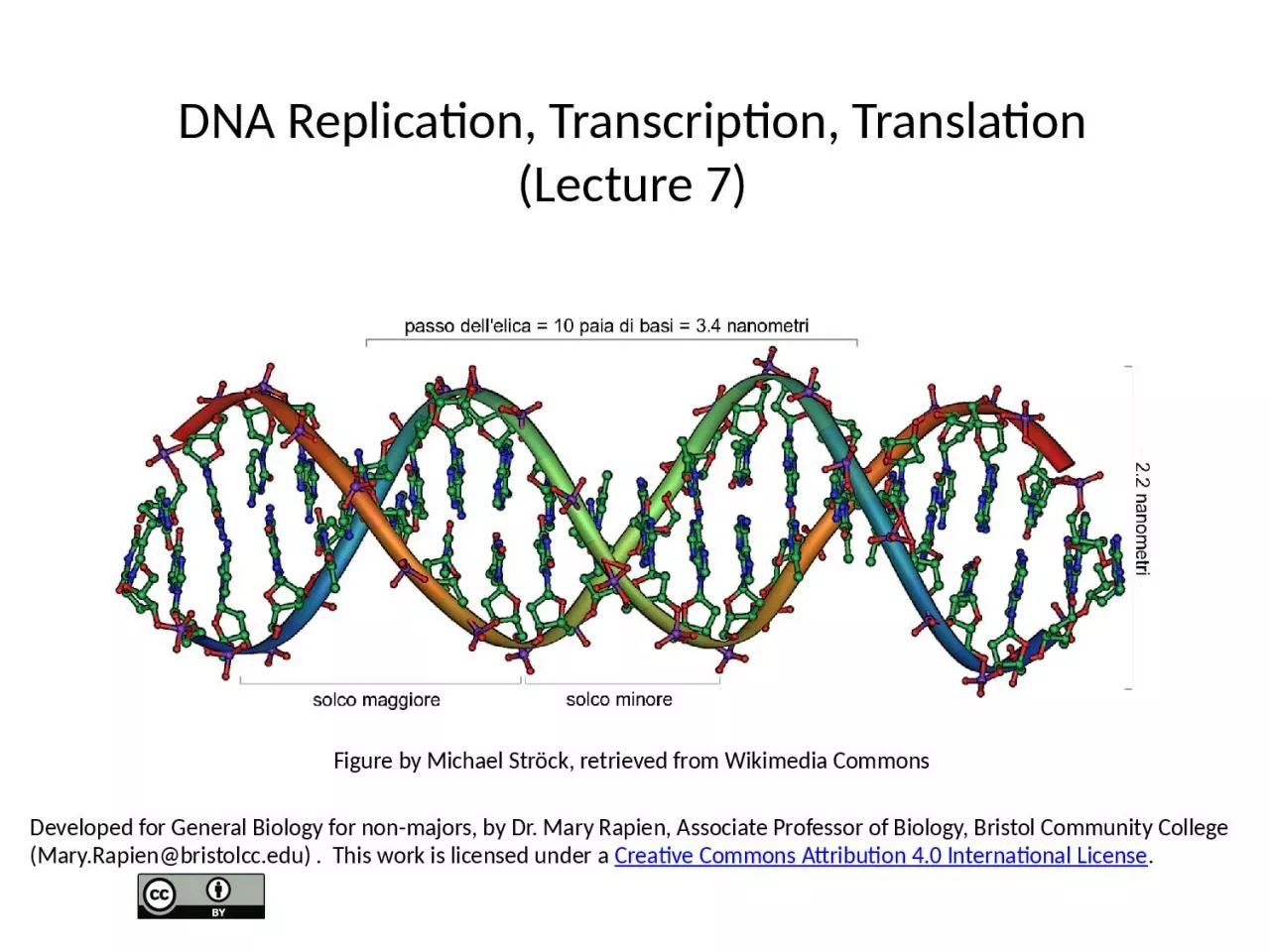

Lecture 7 Figure by Michael Ströck retrieved from Wikimedia Commons Developed for General Biology for nonmajors by Dr Mary Rapien Associate Professor of Biology Bristol Community College MaryRapienbristolccedu This work is licensed under a ID: 1042696
Download Presentation The PPT/PDF document "DNA Replication, Transcription, Translat..." is the property of its rightful owner. Permission is granted to download and print the materials on this web site for personal, non-commercial use only, and to display it on your personal computer provided you do not modify the materials and that you retain all copyright notices contained in the materials. By downloading content from our website, you accept the terms of this agreement.
1. DNA Replication, Transcription, Translation(Lecture 7)Figure by Michael Ströck, retrieved from Wikimedia CommonsDeveloped for General Biology for non-majors, by Dr. Mary Rapien, Associate Professor of Biology, Bristol Community College (Mary.Rapien@bristolcc.edu) . This work is licensed under a Creative Commons Attribution 4.0 International License.
2. DNADNA provides the genetic blueprint for all living organismsAt a basic level, DNA contains the instructions for building proteins. This is the essence of the “Central Dogma” in Biology.
3. DNA 2DNA is composed of two polynucleotide chains joined together by hydrogen bonding between bases, twisted into a helical shapeThe sugar-phosphate backbone is on the outsideThe nitrogenous bases are perpendicular to the backbone in the interior (the “rungs” of the ladder)Specific pairs of bases give the helix a uniform shapeA pairs with T, forming two hydrogen bondsG pairs with C, forming three hydrogen bonds
4. NucleotidesFigure 9.3 OpenStax Concepts of Biology(a) Each DNA nucleotide is made up of a sugar, a phosphate group, and a base.(b) Cytosine and thymine are pyrimidines. Guanine and adenine are purines.
5. The Structure of DNAFigure 9.4 OpenStax Concepts of Biology. DNA (a) forms a double stranded helix, and (b) adenine pairs with thymine and cytosine pairs with guanine. (credit a: modification of work by Jerome Walker, Dennis Myts)
6. Organization of Eukaryotic ChromosomesFigure 9.7 OpenStax Concepts of Biology
7. DNA ReplicationThe two strands of DNA are complementary, meaning the sequence of bases in one strand can be used to create the correct sequence of bases in the other strand.Figure 9.2 OpenStax Concepts of Biology
8. ART ConnectionFigure 9.10 OpenStax Concepts of Biology. A replication fork is formed by the opening of the origin of replication, and helicase separates the DNA strands. An RNA primer is synthesized, and is elongated by the DNA polymerase. On the leading strand, DNA is synthesized continuously, whereas on the lagging strand, DNA is synthesized in short stretches. The DNA fragments are joined by DNA ligase (not shown).
9. Telomere ReplicationFigure 9.11 OpenStax Concepts of Biology. The ends of linear chromosomes are maintained by the action of the telomerase enzyme.
10. Central Dogma of BiologyFigure 9.14 OpenStax Concepts of Biology
11. The Central Dogma involves two main processes:Transcription: Instructions in the gene are copied to mRNATranslation: Instructions in mRNA are used by ribosomes to insert the correct amino acids in the correct sequence to form the protein coded for by that gene
12. TranscriptionFigure 9.16 OpenStax Concepts of Biology. During elongation, RNA polymerase tracks along the DNA template, synthesizes mRNA in the 5' to 3' direction, and unwinds then rewinds the DNA as it is read.
13. Genetic CodeCharacteristics of the genetic codeTriplet: Three nucleotides specify one amino acid61 codons correspond to amino acidsAUG codes for methionine and signals the start of transcription 3 “stop” codons signal the end of translation
14. Genetic Code (cont.)Redundant: More than one codon for some amino acidsUnambiguous: Each codon codes for only one amino acid and does not code for any other amino acidDoes not contain spacers or punctuation: Codons are adjacent to each other with no gaps in betweenNearly universal
15. RNA ProcessingFigure 9.8 OpenStax Concepts of Biology. Eukaryotic mRNA contains introns that must be spliced out. A 5‘cap and 3' tail are also added
16. Protein Synthesis MachineryFigure 9.19 OpenStax Concepts of Biology. The protein synthesis machinery includes the large and small subunits of the ribosome, mRNA, and tRNA. (credit: modification of work by NIGMS, NIH)
17. The Genetic CodeFigure 9.20 OpenStax Concepts of Biology. This figure shows the genetic code for translating each nucleotide triplet, or codon, in mRNA into an amino acid or a termination signal in a nascent protein. (credit: modification of work by NIH)
18. The Mechanism of Protein Synthesis9.21 OpenStax Concepts of Biology. Translation begins when a tRNA anticodon recognizes a codon on the mRNA. The large ribosomal subunit joins the small subunit, and a second tRNA is recruited. As the mRNA moves relative to the ribosome, the polypeptide chain is formed. Entry of a release factor into the A site terminates translation and the components dissociate.
19. MutationsA mutation is a change in the nucleotide sequence of DNABase substitutions: replacement of one nucleotide with anotherEffect depends on whether there is an amino acid change that alters the shape, and therefore function, of the proteinDeletions or insertionsAlter the reading frame of the mRNA, so that nucleotides are grouped into different codons Lead to significant changes in amino acid sequence downstream of mutationCause a nonfunctional polypeptide to be produced
20. Mutations (cont.)Mutations can beSpontaneous: due to errors in DNA replication or recombinationInduced by mutagensHigh-energy radiationChemicals
21. HemoglobinImage credit: Thomas Samuel for ACC-BioinnovationLab
22. FundingThis workforce product was funded by a TAACCCT grant awarded by the U.S. Department of Labor’s Employment and Training Administration. The product was created by the grantee and does not necessarily reflect the official position of the U.S. Department of Labor. The U.S. Department of Labor makes no guarantees, warranties, or assurances of any kind, express or implied, with respect to such information, including any information on linked sites and including, but not limited to, accuracy of the information or its completeness, timeliness, usefulness, adequacy, continued availability, or ownership.